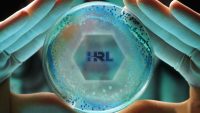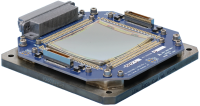Displaying news tagged: HRL
HRL’s Biphasic Coating Sets New Standard in Surface Pathogen Protection

MALIBU, Calif. February 4, 2025 – HRL Laboratories, LLC announces the development of an innovative antimicrobial biphasic polymer coating designed to combat viruses and bacteria on surfaces while maintaining high durability standards in a recently published paper in the journal Langmuir. In collaboration with Boeing and GM, HRL invented a biphasic polyurethane coating that integrates …
Continue reading “HRL’s Biphasic Coating Sets New Standard in Surface Pathogen Protection”
HRL Advances to Camera-Build Phase of Curved Sensor Technology

HRL Laboratories continues to advance curved sensor technology with new funding from DARPA to build an ambitious, first-of-its-kind test camera featuring curved infrared imaging sensors that make wide field-of-view imaging a reality.
HRL to Make SENSE of Analyst Neuro-Ergonomics

HRL Laboratories, LLC, has been selected by the National Geospatial-Intelligence Agency to proceed with Sensemaking Effectiveness using Neurocognitive Signatures of Efficiency (SENSE), a system capable of assessing efficacy of new AI-enabled assistance tools by measuring neurophysiological indicators in the GEOINT analysts using them. Such assessments will help engineers find a proper balance between analyst fatigue and analysis improvement offered by human-machine teaming.
HRL Laboratories Selected for NOM4D Project to Develop Space-Based Construction Technologies

DARPA Program Aims to Revolutionize Large Space Structures by Developing New Techniques for on Orbit Manufacturing
Discover HRL – Part 1

Meet our DEI Specialist, Tess, who talks about a few of the highlights HRL Laboratories has to offer.
The Beginning of a Beautiful Career in Science

Nina, a research engineer at HRL Laboratories, gives an inside view on beginning her professional career in HRL’s Sensors and Electronics Lab while navigating our unusual current social environment.
Aiming to Improve Infrared Cameras by Curving Focal Plane Arrays

HRL Laboratories, LLC, scientists and engineers are taking on the challenge of developing sensors that are doubly-curved, like a bowl, under a new program from the Defense Advanced Research Project Agency (DARPA) sighted on the advancement of infrared (IR) vision. Such curved photographic sensors can enhance clarity throughout an image by bringing its corners into equal focus and brightness as the center.
MACH: Much Faster Than a Speeding Bullet

HRL Laboratories will design architected materials to be used on the leading edges of hypersonic aircraft as part of the Materials Architectures and Characterization for Hypersonics or MACH program from DARPA. Hypersonic vehicles fly at least five times the speed of sound. Leading edges are essential design features because they enable long-range travel at extremely high velocities while maintaining vehicle maneuverability.
NASA Sale Launches HRL Laboratories’ Commercial 3D-Printed Aluminum Effort

HRL Additive, a new commercial effort by HRL Laboratories, LLC, has secured the first commercial sale of its groundbreaking 7A77 high-strength aluminum 3D-printing powder to NASA’s Marshall Space Flight Center. The production plant is dedicated to producing the printable aluminum powder, designated as 7A77, the first additive feedstock registered by the Aluminum Association.
Patent Highlight: System and Method To Detect Attacks On Mobile Wireless Networks Based On Controllability Analysis

Ad hoc mobile networks are extremely useful for soldiers or vehicles that can communicate with each other. However, deployment of these types of communication networks has been limited by security issues. HRL Laboratories’ Gavin Holland explains the patented software system he coinvented to detect misinformation attacks on ad hoc networks.